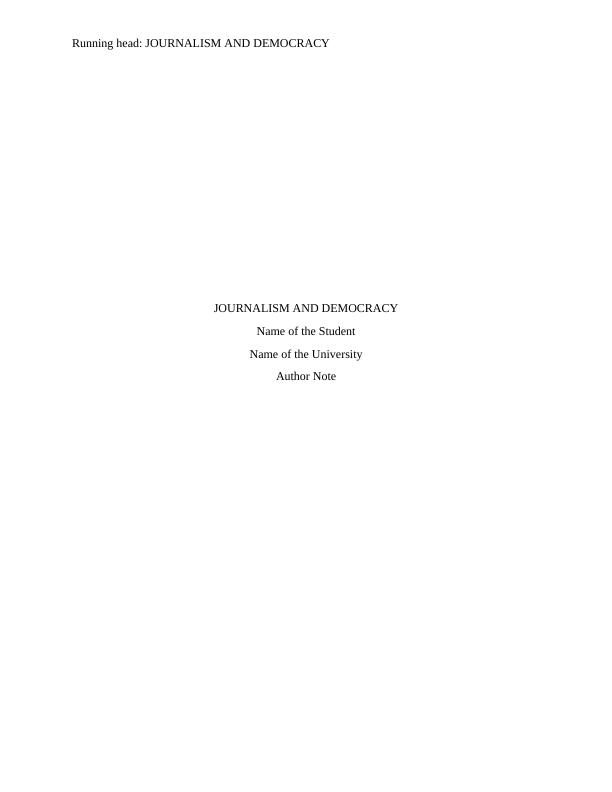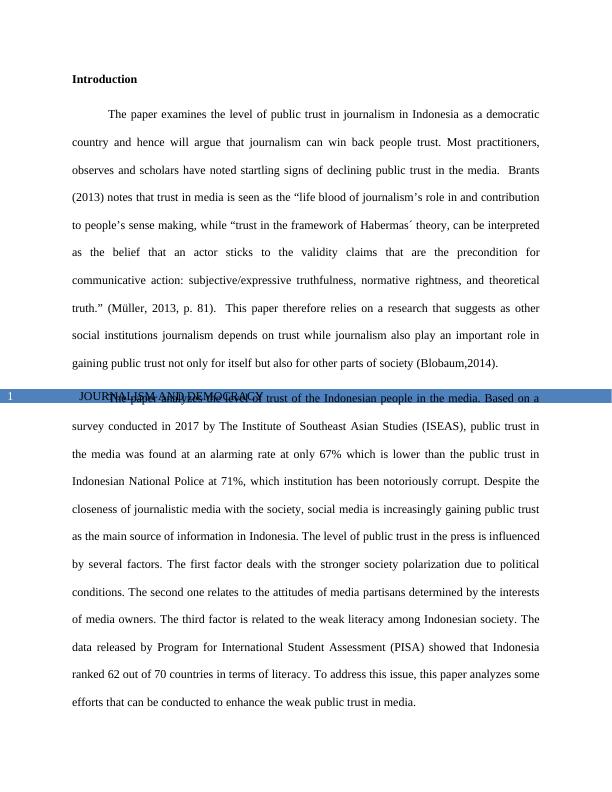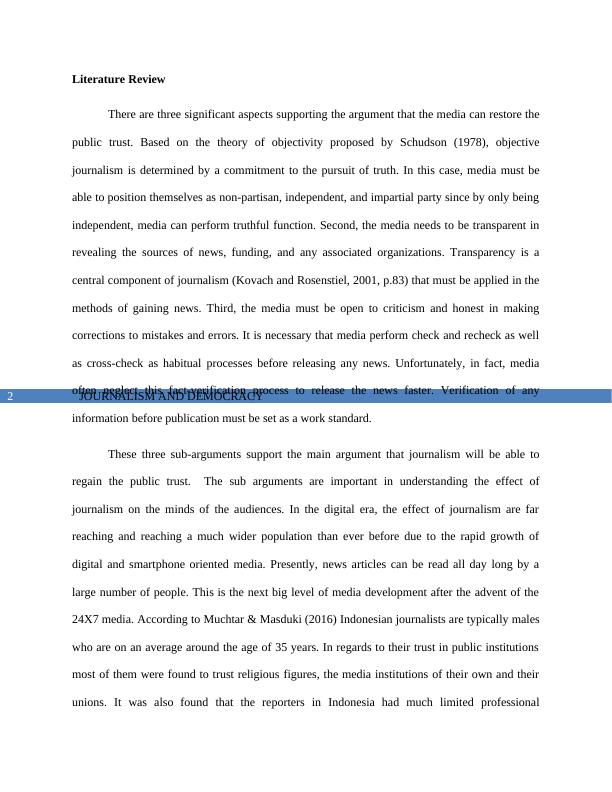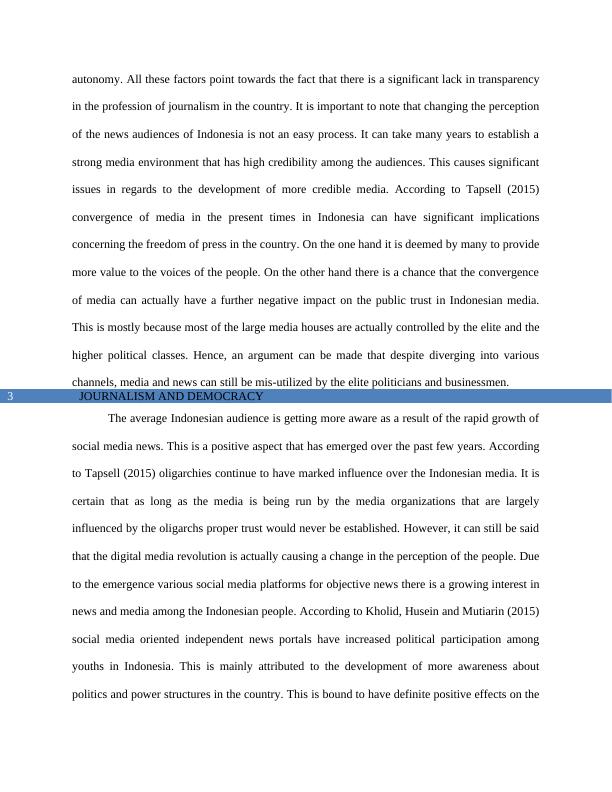Journalism and Democracy (ISEAS) 2022
The paper examines the level of public trust in journalism in Indonesia and argues that journalism can win back people's trust.
11 Pages3077 Words22 Views
Added on 2022-09-10
Journalism and Democracy (ISEAS) 2022
The paper examines the level of public trust in journalism in Indonesia and argues that journalism can win back people's trust.
Added on 2022-09-10
ShareRelated Documents
Running head: JOURNALISM AND DEMOCRACY
JOURNALISM AND DEMOCRACY
Name of the Student
Name of the University
Author Note
JOURNALISM AND DEMOCRACY
Name of the Student
Name of the University
Author Note

JOURNALISM AND DEMOCRACY1
Introduction
The paper examines the level of public trust in journalism in Indonesia as a democratic
country and hence will argue that journalism can win back people trust. Most practitioners,
observes and scholars have noted startling signs of declining public trust in the media. Brants
(2013) notes that trust in media is seen as the “life blood of journalism’s role in and contribution
to people’s sense making, while “trust in the framework of Habermas ́ theory, can be interpreted
as the belief that an actor sticks to the validity claims that are the precondition for
communicative action: subjective/expressive truthfulness, normative rightness, and theoretical
truth.” (Müller, 2013, p. 81). This paper therefore relies on a research that suggests as other
social institutions journalism depends on trust while journalism also play an important role in
gaining public trust not only for itself but also for other parts of society (Blobaum,2014).
The paper analyzes the level of trust of the Indonesian people in the media. Based on a
survey conducted in 2017 by The Institute of Southeast Asian Studies (ISEAS), public trust in
the media was found at an alarming rate at only 67% which is lower than the public trust in
Indonesian National Police at 71%, which institution has been notoriously corrupt. Despite the
closeness of journalistic media with the society, social media is increasingly gaining public trust
as the main source of information in Indonesia. The level of public trust in the press is influenced
by several factors. The first factor deals with the stronger society polarization due to political
conditions. The second one relates to the attitudes of media partisans determined by the interests
of media owners. The third factor is related to the weak literacy among Indonesian society. The
data released by Program for International Student Assessment (PISA) showed that Indonesia
ranked 62 out of 70 countries in terms of literacy. To address this issue, this paper analyzes some
efforts that can be conducted to enhance the weak public trust in media.
Introduction
The paper examines the level of public trust in journalism in Indonesia as a democratic
country and hence will argue that journalism can win back people trust. Most practitioners,
observes and scholars have noted startling signs of declining public trust in the media. Brants
(2013) notes that trust in media is seen as the “life blood of journalism’s role in and contribution
to people’s sense making, while “trust in the framework of Habermas ́ theory, can be interpreted
as the belief that an actor sticks to the validity claims that are the precondition for
communicative action: subjective/expressive truthfulness, normative rightness, and theoretical
truth.” (Müller, 2013, p. 81). This paper therefore relies on a research that suggests as other
social institutions journalism depends on trust while journalism also play an important role in
gaining public trust not only for itself but also for other parts of society (Blobaum,2014).
The paper analyzes the level of trust of the Indonesian people in the media. Based on a
survey conducted in 2017 by The Institute of Southeast Asian Studies (ISEAS), public trust in
the media was found at an alarming rate at only 67% which is lower than the public trust in
Indonesian National Police at 71%, which institution has been notoriously corrupt. Despite the
closeness of journalistic media with the society, social media is increasingly gaining public trust
as the main source of information in Indonesia. The level of public trust in the press is influenced
by several factors. The first factor deals with the stronger society polarization due to political
conditions. The second one relates to the attitudes of media partisans determined by the interests
of media owners. The third factor is related to the weak literacy among Indonesian society. The
data released by Program for International Student Assessment (PISA) showed that Indonesia
ranked 62 out of 70 countries in terms of literacy. To address this issue, this paper analyzes some
efforts that can be conducted to enhance the weak public trust in media.

JOURNALISM AND DEMOCRACY2
Literature Review
There are three significant aspects supporting the argument that the media can restore the
public trust. Based on the theory of objectivity proposed by Schudson (1978), objective
journalism is determined by a commitment to the pursuit of truth. In this case, media must be
able to position themselves as non-partisan, independent, and impartial party since by only being
independent, media can perform truthful function. Second, the media needs to be transparent in
revealing the sources of news, funding, and any associated organizations. Transparency is a
central component of journalism (Kovach and Rosenstiel, 2001, p.83) that must be applied in the
methods of gaining news. Third, the media must be open to criticism and honest in making
corrections to mistakes and errors. It is necessary that media perform check and recheck as well
as cross-check as habitual processes before releasing any news. Unfortunately, in fact, media
often neglect this fact-verification process to release the news faster. Verification of any
information before publication must be set as a work standard.
These three sub-arguments support the main argument that journalism will be able to
regain the public trust. The sub arguments are important in understanding the effect of
journalism on the minds of the audiences. In the digital era, the effect of journalism are far
reaching and reaching a much wider population than ever before due to the rapid growth of
digital and smartphone oriented media. Presently, news articles can be read all day long by a
large number of people. This is the next big level of media development after the advent of the
24X7 media. According to Muchtar & Masduki (2016) Indonesian journalists are typically males
who are on an average around the age of 35 years. In regards to their trust in public institutions
most of them were found to trust religious figures, the media institutions of their own and their
unions. It was also found that the reporters in Indonesia had much limited professional
Literature Review
There are three significant aspects supporting the argument that the media can restore the
public trust. Based on the theory of objectivity proposed by Schudson (1978), objective
journalism is determined by a commitment to the pursuit of truth. In this case, media must be
able to position themselves as non-partisan, independent, and impartial party since by only being
independent, media can perform truthful function. Second, the media needs to be transparent in
revealing the sources of news, funding, and any associated organizations. Transparency is a
central component of journalism (Kovach and Rosenstiel, 2001, p.83) that must be applied in the
methods of gaining news. Third, the media must be open to criticism and honest in making
corrections to mistakes and errors. It is necessary that media perform check and recheck as well
as cross-check as habitual processes before releasing any news. Unfortunately, in fact, media
often neglect this fact-verification process to release the news faster. Verification of any
information before publication must be set as a work standard.
These three sub-arguments support the main argument that journalism will be able to
regain the public trust. The sub arguments are important in understanding the effect of
journalism on the minds of the audiences. In the digital era, the effect of journalism are far
reaching and reaching a much wider population than ever before due to the rapid growth of
digital and smartphone oriented media. Presently, news articles can be read all day long by a
large number of people. This is the next big level of media development after the advent of the
24X7 media. According to Muchtar & Masduki (2016) Indonesian journalists are typically males
who are on an average around the age of 35 years. In regards to their trust in public institutions
most of them were found to trust religious figures, the media institutions of their own and their
unions. It was also found that the reporters in Indonesia had much limited professional

JOURNALISM AND DEMOCRACY3
autonomy. All these factors point towards the fact that there is a significant lack in transparency
in the profession of journalism in the country. It is important to note that changing the perception
of the news audiences of Indonesia is not an easy process. It can take many years to establish a
strong media environment that has high credibility among the audiences. This causes significant
issues in regards to the development of more credible media. According to Tapsell (2015)
convergence of media in the present times in Indonesia can have significant implications
concerning the freedom of press in the country. On the one hand it is deemed by many to provide
more value to the voices of the people. On the other hand there is a chance that the convergence
of media can actually have a further negative impact on the public trust in Indonesian media.
This is mostly because most of the large media houses are actually controlled by the elite and the
higher political classes. Hence, an argument can be made that despite diverging into various
channels, media and news can still be mis-utilized by the elite politicians and businessmen.
The average Indonesian audience is getting more aware as a result of the rapid growth of
social media news. This is a positive aspect that has emerged over the past few years. According
to Tapsell (2015) oligarchies continue to have marked influence over the Indonesian media. It is
certain that as long as the media is being run by the media organizations that are largely
influenced by the oligarchs proper trust would never be established. However, it can still be said
that the digital media revolution is actually causing a change in the perception of the people. Due
to the emergence various social media platforms for objective news there is a growing interest in
news and media among the Indonesian people. According to Kholid, Husein and Mutiarin (2015)
social media oriented independent news portals have increased political participation among
youths in Indonesia. This is mainly attributed to the development of more awareness about
politics and power structures in the country. This is bound to have definite positive effects on the
autonomy. All these factors point towards the fact that there is a significant lack in transparency
in the profession of journalism in the country. It is important to note that changing the perception
of the news audiences of Indonesia is not an easy process. It can take many years to establish a
strong media environment that has high credibility among the audiences. This causes significant
issues in regards to the development of more credible media. According to Tapsell (2015)
convergence of media in the present times in Indonesia can have significant implications
concerning the freedom of press in the country. On the one hand it is deemed by many to provide
more value to the voices of the people. On the other hand there is a chance that the convergence
of media can actually have a further negative impact on the public trust in Indonesian media.
This is mostly because most of the large media houses are actually controlled by the elite and the
higher political classes. Hence, an argument can be made that despite diverging into various
channels, media and news can still be mis-utilized by the elite politicians and businessmen.
The average Indonesian audience is getting more aware as a result of the rapid growth of
social media news. This is a positive aspect that has emerged over the past few years. According
to Tapsell (2015) oligarchies continue to have marked influence over the Indonesian media. It is
certain that as long as the media is being run by the media organizations that are largely
influenced by the oligarchs proper trust would never be established. However, it can still be said
that the digital media revolution is actually causing a change in the perception of the people. Due
to the emergence various social media platforms for objective news there is a growing interest in
news and media among the Indonesian people. According to Kholid, Husein and Mutiarin (2015)
social media oriented independent news portals have increased political participation among
youths in Indonesia. This is mainly attributed to the development of more awareness about
politics and power structures in the country. This is bound to have definite positive effects on the

End of preview
Want to access all the pages? Upload your documents or become a member.
Related Documents
The Media as a Watchdog: Role, Responsibilities, and Challengeslg...
|15
|3933
|460
